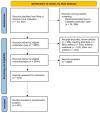Systematic Mapping of Research on Vaccine-Preventable Diseases in Children in Sub-Saharan Africa: A Decennial Scientometric Analysis
- PMID: 37766183
- PMCID: PMC10537484
- DOI: 10.3390/vaccines11091507
Systematic Mapping of Research on Vaccine-Preventable Diseases in Children in Sub-Saharan Africa: A Decennial Scientometric Analysis
Abstract
Vaccine-preventable diseases (VPDs) remain a significant public health challenge, particularly in sub-Saharan Africa. The high burden of VPDs in this region necessitates the need for continued investigation and intervention. This paper presents a bibliometric analysis of research on VPDs in children in sub-Saharan Africa in the last 10 years to capture the current state of research in the field. This study used a systematic search for articles published between 2013 and 2022 in the Web of Science Core Collection database and, subsequently, scientometric techniques for data analyses and interpretation. Annual scientific production of publications on the research of VPDs in children in sub-Saharan Africa increased from 2013 to 2019 and then gradually declined. South Africa had the most VPD studies (n = 148; 16.2%), followed by Nigeria, Ghana, Kenya, The Gambia, Malawi, Ethiopia, and the Republic of Congo. The Vaccine journal published the most. The Pan African Medical Journal was the most frequent destination journal based in Africa. The commonly studied pathogens were Streptococcus pneumoniae and Haemophilus influenzae. Research productivity increased exponentially in the pre-COVID era and declined in the past two years, so more VPD research in this region is needed.
Keywords: Africa; VPDs; bibliometric analysis; scientometric analysis; vaccine preventable diseases.
Conflict of interest statement
The authors declare no conflict of interest.
Figures










Similar articles
-
Folic acid supplementation and malaria susceptibility and severity among people taking antifolate antimalarial drugs in endemic areas.Cochrane Database Syst Rev. 2022 Feb 1;2(2022):CD014217. doi: 10.1002/14651858.CD014217. Cochrane Database Syst Rev. 2022. PMID: 36321557 Free PMC article.
-
A SARS-CoV-2 Surveillance System in Sub-Saharan Africa: Modeling Study for Persistence and Transmission to Inform Policy.J Med Internet Res. 2020 Nov 19;22(11):e24248. doi: 10.2196/24248. J Med Internet Res. 2020. PMID: 33211026 Free PMC article.
-
Bibliometric trends of health economic evaluation in Sub-Saharan Africa.Global Health. 2016 Aug 24;12(1):50. doi: 10.1186/s12992-016-0188-2. Global Health. 2016. PMID: 27558556 Free PMC article. Review.
-
Terrorist Attacks in Sub-Saharan Africa from 1970 through 2020: Analysis and Impact from a Counter-Terrorism Medicine Perspective.Prehosp Disaster Med. 2023 Apr;38(2):216-222. doi: 10.1017/S1049023X23000080. Epub 2023 Jan 30. Prehosp Disaster Med. 2023. PMID: 36710636
-
Pattern and determinants of HIV research productivity in sub-Saharan Africa: bibliometric analysis of 1981 to 2009 PubMed papers.BMC Infect Dis. 2010 Mar 5;10:47. doi: 10.1186/1471-2334-10-47. BMC Infect Dis. 2010. PMID: 20205717 Free PMC article.
Cited by
-
Vaccine Research Trends in Africa from 2016 to Mid-2024: A Bibliometric Analysis.Vaccines (Basel). 2025 May 12;13(5):509. doi: 10.3390/vaccines13050509. Vaccines (Basel). 2025. PMID: 40432119 Free PMC article. Review.
References
-
- World Health Organization (WHO) The Global Vaccine Action Plan 2011–2020. Review and Lessons Learned. [(accessed on 1 June 2023)]. Available online: https://www.who.int/publications/i/item/global-vaccine-action-plan-and-d....
-
- World Health Organization (WHO) Business Case for WHO Immunization Activities on the African Continent. WHO; Geneva, Switzerland: 2018.
-
- Causey K., Fullman N., Sorensen R.J.D., Galles N.C., Zheng P., Aravkin A., Danovaro-Holliday M.C., Martinez-Piedra R., Sodha S.V., Velandia-González M.P., et al. Estimating Global and Regional Disruptions to Routine Childhood Vaccine Coverage during the COVID-19 Pandemic in 2020: A Modelling Study. Lancet. 2021;398:522–534. doi: 10.1016/S0140-6736(21)01337-4. - DOI - PMC - PubMed
-
- Amoako-Sakyi D., Obiri-Yeboah D., Ofosu A., Kusi K.A., Osei K., Adade R., Aniakwaa-Bonsu E., Quansah R., Arko-Mensah J., Amoah B.Y., et al. Preponderance of Vaccine-Preventable Diseases Hotspots in Northern Ghana: A Spatial and Space-Time Clustering Analysis from 2010 to 2014. BMC Public Health. 2022;22:1899. doi: 10.1186/s12889-022-14307-1. - DOI - PMC - PubMed
Grants and funding
LinkOut - more resources
Full Text Sources
Miscellaneous

